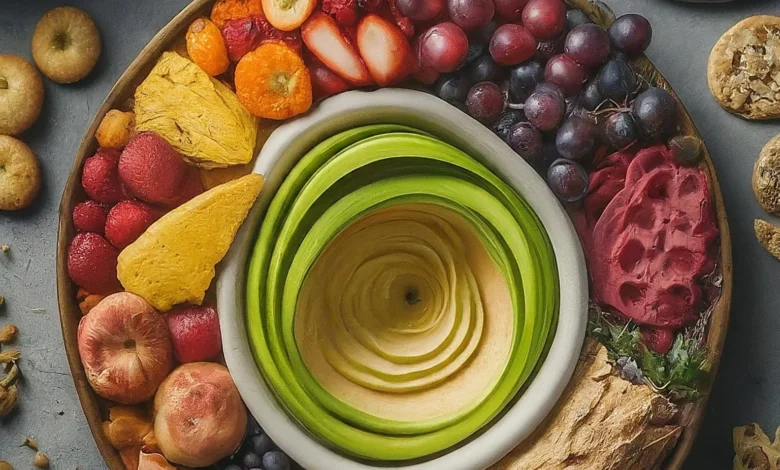Developing a Mindful Eating Practice for Brain Health

Did you know that how you eat might be just as important for your brain as what you eat? Let’s explore this fascinating idea.
The Power of Mindful Eating
A recent study found some exciting news. People who practice mindful eating have better brain function. They’re also less likely to experience cognitive decline as they age. But what exactly is mindful eating?
What is Mindful Eating?
Mindful eating means paying full attention to your food and the act of eating. It’s about being present in the moment. When you eat mindfully, you notice:
- The colors of your food
- How your food smells
- The texture of each bite
- All the flavors in your meal
But it’s more than just enjoying your food. Mindful eating also involves:
- Listening to your body’s hunger and fullness signals
- Eating without distractions (like TV or phones)
- Being aware of your emotions while eating
How Mindful Eating Boosts Your Brain
You might wonder, “How can paying more attention to my food help my brain?” Let’s look at what science tells us.
Your Brain on Mindful Eating
When you eat mindfully, you’re not just feeding your body. You’re also exercising your brain. Research shows some amazing benefits:
- Increased brain activity: Mindful eating boosts activity in your prefrontal cortex. This is the part of your brain that helps you make decisions and control impulses.
- Better brain connections: It helps your brain form new connections. This is called neuroplasticity.
- Improved focus: Mindful eating can help you concentrate better in all areas of life.
Less Stress, Better Thinking
Mindful eating is a form of meditation. It can help lower your stress levels by:
- Reducing stress hormones in your body
- Helping you relax
- Improving how you handle emotions
When you’re less stressed, your brain works better. You might notice:
- Improved memory
- Easier learning
- Clearer thinking
Happy Gut, Happy Brain
When you eat mindfully, you tend to chew more and eat more slowly. This can lead to:
- Better digestion: Your body can absorb more nutrients from your food.
- Healthier gut: A healthy gut is linked to a healthy brain through the gut-brain connection.
- Weight control: You’re less likely to overeat, which helps prevent obesity. Obesity can harm brain health.
Start Your Mindful Eating Journey
By practicing mindful eating, you’re not just changing how you eat. You’re potentially boosting your brain health and thinking skills.
Key Principles of Mindful Eating
To practice mindful eating effectively, it’s important to understand its core principles. Let’s explore these key ideas:
- Eat slowly and without distraction
- Listen to your body’s hunger cues
- Engage all your senses
- Notice your emotional and physical responses to food
Eating Slowly and Without Distraction
When you eat slowly and focus solely on your meal, you:
- Give your brain time to register fullness
- Enjoy your food more
- Improve digestion
Tip: Try putting your fork down between bites to slow your pace.
Listening to Physical Hunger Cues
Your body sends signals when it needs food and when it’s full. Mindful eating helps you tune into these signals:
- Eat when you feel genuinely hungry
- Stop eating when you feel comfortably full
Tip: Before eating, rate your hunger on a scale of 1-10. This helps you recognize true hunger.
Engaging All Senses
Mindful eating involves experiencing your food with all five senses:
- Look at the colors and shapes on your plate
- Smell the aromas of your food
- Feel the textures in your mouth
- Listen to the sounds as you chew
- Taste the various flavors in each bite
Tip: Try closing your eyes while eating to heighten your other senses.
Noting Emotional and Physical Responses
Pay attention to how different foods make you feel:
- Do certain foods give you energy or make you sluggish?
- How does your mood change after eating?
- Are there foods that upset your stomach?
Tip: Keep a food journal to track these responses over time.
Getting Started with Mindful Eating
Now that you understand the principles, let’s look at how to begin your mindful eating practice.
Setting the Environment
Create a calm eating space:
- Clear the table of non-eating items
- Turn off screens (TV, phone, computer)
- Use pleasant lighting and comfortable seating
Pre-Meal Mindfulness Exercise
Before eating, try this simple exercise:
- Sit comfortably and take three deep breaths
- Notice any sensations in your body
- Observe your hunger level
- Take a moment to feel grateful for your meal
Mindful Food Selection Tips
Choose foods that nourish both body and mind:
- Pick a variety of colorful fruits and vegetables
- Include whole grains and lean proteins
- Consider how each food might benefit your brain health
Mindful vs. Mindless Eating: A Comparison
Here’s a simple table to illustrate the differences:
| Mindful Eating | Mindless Eating |
|---|---|
| Eating slowly | Eating quickly |
| Paying attention to food | Distracted while eating |
| Stopping when full | Overeating |
| Choosing nourishing foods | Eating whatever is available |
| Enjoying each bite | Barely tasting food |
Mindful Eating Techniques for Brain Health
Let’s explore some powerful techniques that combine mindful eating with brain-boosting benefits.
The Raisin Exercise
This classic mindfulness practice uses a single raisin to engage all your senses:
- Look at the raisin, noticing its color, shape, and texture.
- Feel the raisin in your hand, noting its weight and texture.
- Smell the raisin, paying attention to any aromas.
- Place the raisin in your mouth without chewing. Notice how it feels on your tongue.
- Chew the raisin slowly, focusing on the taste and texture.
- Swallow the raisin, following the sensation as it moves down your throat.
Key Takeaway: This exercise trains your brain to focus intensely on a single object, enhancing concentration and mindfulness.
Chewing Meditation
This technique combines eating with meditation:
- Take a bite of food and chew it 20-30 times.
- Focus solely on the act of chewing.
- Notice the changing taste and texture as you chew.
- Swallow mindfully before taking the next bite.
Key Takeaway: This practice improves digestion and helps you eat less while feeling more satisfied.
Mindful Portion Control
Use this technique to become more aware of portion sizes:
- Use smaller plates to make portions look larger.
- Serve yourself half of what you think you want.
- Eat slowly and check in with your fullness level.
- Only get seconds if you’re still truly hungry.
Key Takeaway: This method helps prevent overeating and promotes better weight management, which is crucial for brain health.
Brain-Boosting Foods to Include in Your Mindful Eating Practice
Combine mindful eating with these brain-friendly foods for maximum benefit:
Omega-3 Rich Foods
Omega-3 fatty acids are essential for brain health. Include:
- Fatty fish (salmon, mackerel, sardines)
- Walnuts
- Flaxseeds
- Chia seeds
Mindful Tip: As you eat these foods, imagine them nourishing your brain cells.
Antioxidant-Packed Fruits and Vegetables
Antioxidants protect your brain from oxidative stress. Choose:
- Berries (blueberries, strawberries, blackberries)
- Leafy greens (spinach, kale, collard greens)
- Colorful vegetables (bell peppers, carrots, sweet potatoes)
Mindful Tip: Notice the vibrant colors of these foods as you eat them, appreciating their protective properties.
Whole Grains and Lean Proteins
These provide steady energy for your brain:
- Quinoa
- Brown rice
- Oats
- Lean meats
- Legumes
Mindful Tip: Pay attention to how these foods make you feel energized and focused.
Overcoming Common Challenges in Mindful Eating
Adopting a new habit can be tricky. Here are some common challenges you might face with mindful eating and how to overcome them:
Dealing with Time Constraints
- Start small: Begin with one mindful meal per day
- Practice mini-mindfulness: Take three mindful bites during each meal
- Prep in advance: Plan and prepare meals ahead of time to reduce rush
Managing Social Eating Situations
- Communicate: Let others know about your mindful eating practice
- Choose wisely: Select restaurants that align with your goals
- Pace yourself: Use conversation breaks to slow down your eating
Addressing Emotional Eating
- Pause before eating: Ask yourself if you’re physically hungry or emotionally driven
- Find alternatives: Develop non-food ways to cope with emotions (e.g., walking, journaling)
- Practice self-compassion: Don’t be hard on yourself if you slip up
Integrating Mindful Eating into Daily Life
Make mindful eating a sustainable part of your routine with these strategies:
Creating a Mindful Eating Schedule
- Set regular meal times: This helps regulate hunger and fullness cues
- Allow time for meals: Schedule at least 20 minutes for each meal
- Plan mindful snacks: Choose specific times for intentional, mindful snacking
Mindful Grocery Shopping and Meal Planning
- Shop with a list: Avoid impulsive purchases by planning ahead
- Choose whole foods: Opt for items with minimal processing
- Read labels mindfully: Pay attention to ingredients and nutritional information
Incorporating Mindfulness into Food Preparation
- Focus on the process: Engage all senses while cooking
- Practice gratitude: Appreciate the ingredients and effort involved
- Minimize distractions: Turn off the TV and put away your phone while cooking
Measuring Progress and Sustaining the Practice
Track your mindful eating journey to stay motivated and see improvements:
Keeping a Mindful Eating Journal
Record your experiences, including:
- Hunger and fullness levels before and after meals
- Emotions associated with eating
- Physical sensations during and after meals
Setting Realistic Goals and Tracking Improvements
- Start small: Set achievable weekly goals
- Be specific: Instead of “eat better,” try “eat one mindful meal per day”
- Track progress: Note improvements in portion control, eating speed, and food choices
Celebrating Small Victories
- Acknowledge progress: Recognize even small positive changes
- Share successes: Tell friends or family about your achievements
- Reward yourself: Choose non-food rewards for reaching milestones
Weekly Mindful Eating Tracker
| Day | Ate slowly | No distractions | Stopped when full | Enjoyed my food |
|---|---|---|---|---|
| Monday | ☐ | ☐ | ☐ | ☐ |
| Tuesday | ☐ | ☐ | ☐ | ☐ |
| Wednesday | ☐ | ☐ | ☐ | ☐ |
| Thursday | ☐ | ☐ | ☐ | ☐ |
| Friday | ☐ | ☐ | ☐ | ☐ |
| Saturday | ☐ | ☐ | ☐ | ☐ |
| Sunday | ☐ | ☐ | ☐ | ☐ |
Conclusion
Developing a mindful eating practice is a powerful way to boost your brain health. Let’s recap the key benefits:
- Enhanced cognitive function: Mindful eating can improve focus, memory, and decision-making skills.
- Stress reduction: The practice helps lower stress levels, which is crucial for brain health.
- Better nutrient absorption: By eating slowly and mindfully, you help your body extract more nutrients from your food.
- Improved relationship with food: Mindful eating can help address emotional eating and promote a healthier attitude towards food.
Remember, the journey to mindful eating is just that – a journey. Start small, be patient with yourself, and celebrate each step forward. Every mindful bite is a step towards better brain health and overall well-being.
Now it’s your turn to begin your mindful eating journey. Start with one mindful meal today. Pay attention to your food, engage all your senses, and notice how it makes you feel. Your brain will thank you for it!



